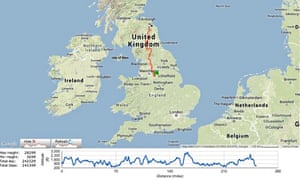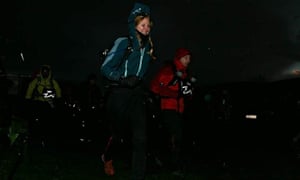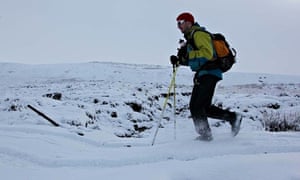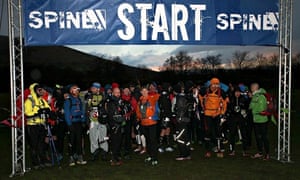“Mate, I’m broken. I’ve been planning this for a year and now I’m out. I can’t believe it. What am I going to do?”
With the haunted look of a man who had been on his feet for 30 hours and bloodshot eyes betraying a recent cry, I couldn’t argue with his assessment. I’d seen him on the Spine training weekend in November and now here he was, distraught, in a cafe in Malham village – about 80 miles into the race, with another 188 to go.
It was Sunday afternoon and we’d been racing since leaving Edale in a surprise snow-shower at 8am on the Saturday morning – across treacherous icy flagstones, through endless energy-sapping mud and over fields that had morphed into lakes during one of the wettest Januarys on record. I guess I must have been ahead of him on day one – until I stopped off at 3am for a couple of hours’ sleep in the motorhome my brother Tim had kindly agreed to drive. The rest had rejuvenated me – but the runner before me had pressed on through the night.
I said sympathetic things while the folks at the cafe prepared a couple of tuna rolls, a takeaway tea and a slice of carrot cake (running for 20+ hours a day burns off 8,000-10,000 calories – so a pocketful of energy gels isn’t going to do it) but he was inconsolable; there was nothing I could do.

I said my goodbyes, paid up and pushed on. I was still feeling ok physically and had been consciously holding myself back to conserve energy, knowing that if all went to plan I wouldn’t be reaching the finish line in Kirk Yetholm until Thursday afternoon at the earliest – maybe a day later if things got difficult. I didn’t cross my mind that in five or six hours I’d be out of the race too.
A short climb past the spectacular limestone cliff of Malham Cove brought me to the tarn – and a mini checkpoint staffed by polar veteran John Bamber – in good spirits. I was surprised to hear I was in the top 10, and John warned dryly that coming through Malham that quickly meant “you’re either superman – or you’re going to drop”. He must have seen my smile waver, quickly reassuring me that he had no doubt I was of course some kind of superhero …
A couple more cups of sweet tea and a handful of biltong later, and I was out of the door and on my way; still feeling ok and keen to get to Hawes before midnight so I could rest and recuperate before striking out for Middleton-in-Teesdale.

Because it takes place in January, Spine racers spend up to 16 hours out of every 24 running in the dark. As I reached the shoulder of Pen y Ghent (“Hill of winds”, possibly. I’m not going to argue …) a couple of hours later, I was being battered by ferocious winds: horizontal rain and sleet were testing my waterproof gear, visibility with my head torch was down to a couple of metres and I hadn’t seen another runner since Malham Tarn. I began to worry about the short rocky scramble ahead.
Being the kind of runner who enjoys meticulously planning for a race, I’d run/walked the length of the Pennine Way over a few weekends last autumn – and remembered taking a wrong line on the steep route ahead. I knew the same mistake could put me in serious trouble alone, at night, on icy rocks and with no mobile phone reception. I thought of my family – and the possible consequences if mountain rescue were called out to save me, or worse …
Retracing my steps to a clear track I hung around for a while hoping another runner would arrive so we could push over the top together. In retrospect I should have looked for a less exposed spot, because as I grew colder and wetter it dawned on me that I was increasingly hoping no one would come past. I ummed and ahhed for what seemed like an age before reluctantly making the decision to DNF.
I bailed to Horton and, after a quick call to race control to let them know I was calling it a day, found solace in front of a pub fire with a couple of pints and a huge, steaming bowl of chilli while I waited for Tim. I was tired and sore and pleased to be somewhere warm – but also angry with myself for giving up so easily. Like the runner in the cafe said – all those months of training, all those back-to-back winter long runs; even a long weekend forcing myself out of bed at 4am for three days to run 25 miles with a full pack to try to acclimatise my body and mind to the sleep deprivation I knew lay ahead … All for nothing.

The next day I found out that a big chunk of the field had dropped on the Sunday night in “absolutely horrendous conditions” – but that didn’t rid me of the nagging feeling of failure. I was physically, mentally and emotionally exhausted – as you expect to be after an ultra – but the closure you get when you cross the finish line was lacking this time round. For the next few days I obsessively followed the race’s Open Tracker page on my smartphone – genuinely pleased for the runners I knew who were gutting it out and making steady progress towards Kirk Yetholm – and beating myself up about my first DNF. When friends left messages congratulating me on a “fantastic achievement” or telling me how I should feel proud for even trying a race like the Spine, I just ignored them.
Psychologist Fiona Beddoes-Jones of the Cognitive Fitness Consultancy says coping with a DNF is a bit like going through the grief process – runners pass through stages of anger, despair and resignation – before finally picking themselves up and moving on.
During a week spent supporting the race she encountered a fair few despondent non-finishers and a couple who were completely distraught. “There’s very little you can do to support them – other than be there and listen,” she told me later. “They don’t want to hear that this feeling will pass and they’ll feel better – they want to wallow in it. It is positive to allow them to do that – although there is a danger they might want to wallow for too long.”
Last year, snow and ice along virtually the whole route made for some attention-grabbing photos – but there is an argument that the warm, wet and windy conditions of 2014 were just as tough.

In the end, out of 80 Spine Race starters, just 30 made it to Kirk Yetholm. The drop-out rate was highest at the sharp end of the field – from 11 “ones to watch” picked by a leading ultrarunning website, only two (Neil Bryant in seventh and Charlie Sharpe in 11th) finished the race. Czech photographer Pavel Paloncy won in four days, 14 hours and 45 minutes – smashing the course record by 14 hours, during which he only slept for a total of five hours.
Race director Scott Gilmour – who ended up pretty sleep deprived himself after a manic week organising checkpoints, support teams, medics, trackers and even a chef – says the Spine is more an adventure footrace which appeals to ultrarunners than an ultramarathon. “I think it’s almost perfect in its cruelty,” he told Summit Fever TV in an interview. “It’s brutal – but it’s achievable.”
Sadly, not for me. But there’s no doubt the Spine delivers an epic adventure, without having to leave Britain. Arriving back home after the race I discovered a new-found appreciation of routine comforts; for a while a soft, warm bed, a beer, staying still … all seem like blissful, sumptuous luxuries to be savoured.

Beddoes-Jones says runners can help themselves prepare for a DNF or race-stopping injury by considering every possible scenario before an event – by thinking through how they’d deal with the negatives as well as the positives. If you do drop out, then be sure to analyse what went wrong and learn from the experience before moving on, she says.
Could I have done anything differently? Personally, I felt well prepared – although perhaps a little overtrained. In hindsight it should have been obvious my schedule would see me scrambling up Pen y Ghent in the dark – so a couple more trips up there before the race would have given me the confidence I lacked. Could I have gone on to complete the remaining 170 miles? Who knows.
I ran my first ultra 18 months ago – and have since been pushing my boundaries of distance and difficulty. One lesson I thought I’d learned from DNFing the Spine was that my upper limit lay somewhere below attempting 268-mile single-stage races in winter. After a few days, though, my “never again” had predictably turned into a “maybe”. You can see where this might be going…
2015 entries for the Spine Race are now open
Source: Read Full Article
